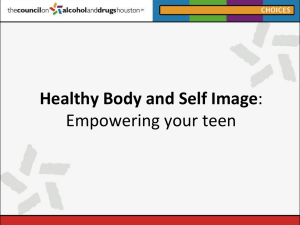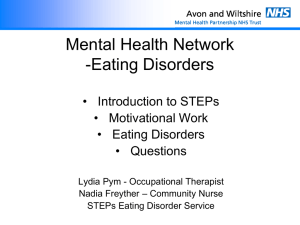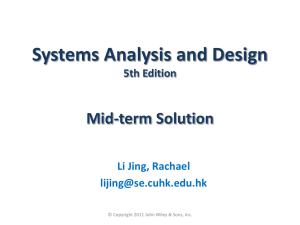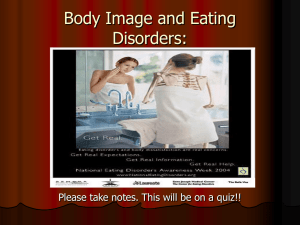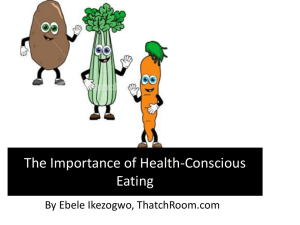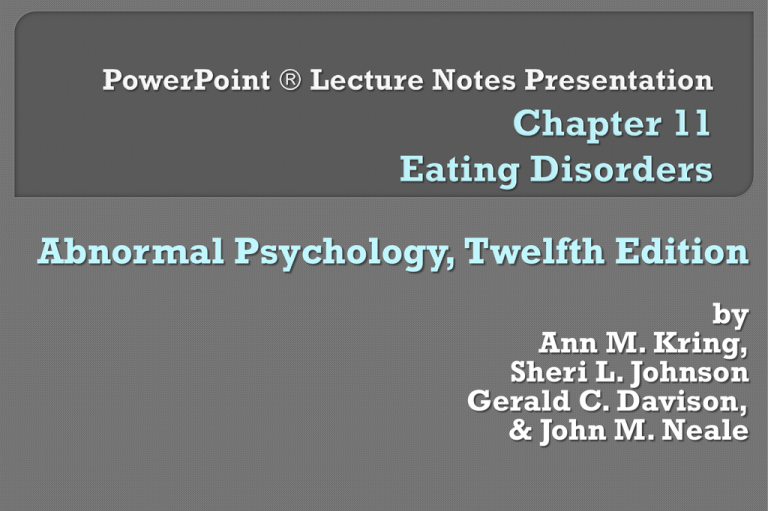
Abnormal Psychology, Twelfth Edition
by
Ann M. Kring,
Sheri L. Johnson
Gerald C. Davison,
& John M. Neale
Chapter
11: Eating Disorders
I. Anorexia Nervosa
II. Bulimia Nervosa
III. Binge Eating Disorder
IV. Etiology of Eating Disorders
V. Treatment of Eating Disorders
Copyright 2012 John Wiley & Sons, Inc.
2
Eating
disorders are severe disturbances in
eating behaviors, such as eating too little or
eating too much
Current
DSM-IV Eating Disorder Diagnostic
Categories:
• Anorexia Nervosa
• Bulimia Nervosa
Copyright 2012 John Wiley & Sons, Inc.
3
Proposed DSM-5 Changes:
• Adding Binge Eating Disorder as a new diagnostic
category, rather than a condition in need of further
study, as it currently is in the DSM-IV
• Eating Disorders likely to become part of “Feeding and
Eating Disorders” group
Feeding Disorders such as Pica (eating non-food
substances for extended periods) and Rumination
Disorder (repeated regurgitation of foods) are
currently categorized in DSM-IV under Disorders
usually first diagnosed in Infancy, Childhood, or
Adolescence
Copyright 2012 John Wiley & Sons, Inc.
4
DSM-IV
Diagnostic Criteria:
1. Refusal to maintain normal body weight
Less than 85%
2. Intense fear of gaining weight and being fat
Can’t be ‘too thin’
3. Distorted body image or sense of body shape
Feel “fat” even when emaciated
4. Amenorrhea
Loss of menstrual period
Copyright 2012 John Wiley & Sons, Inc.
5
Likely
DSM-5 Criteria:
1. Restriction of behaviors that promote healthy weight;
body weight is significantly below normal
BMI (Body Mass Index) less than 18.5 for adults
2. Intense fear of gaining weight and being fat
Can’t be ‘too thin’
3. Distorted body image or sense of body shape
Feel “fat” even when emaciated
(Amenorrhea not required for diagnosis)
Copyright 2012 John Wiley & Sons, Inc.
6
Two subtypes
• Restricting
of Anorexia Nervosa:
weight loss is achieved by severely limiting food
intake, with no binge-eating/purging during the
last three months
• Binge-eating/purging
the person has also regularly engaged in bingeeating and purging during the last three months
Longitudinal
research suggests
questionable validity of subtypes
Copyright 2012 John Wiley & Sons, Inc.
7
DSM-5 DIAGNOSES
Anorexia Nervosa
KEY CHANGES FROM DSM-IV
Restriction of behaviors that
promote healthy weight
rather than “refusal to eat”
In addition to fear of weight
gain, a focus on behaviors
that interfere with weight
gain
Loss of menstrual period no
longer required for diagnosis
Subtypes specified for past
three months rather than just
current episode
Copyright 2012 John Wiley & Sons, Inc.
8
Copyright 2012 John Wiley & Sons, Inc.
9
Copyright John Wiley & Sons, Inc.
Copyright 2012 John Wiley & Sons, Inc.
10
Onset: early to middle teen years
Usually triggered by dieting and stress
Women 10x as likely to develop disorder
as men
• Symptomatology in men similar to that of
women
Often comorbid with depression, OCD, phobias,
panic, alcoholism and PDs
• In men, comorbid with substance dependence,
mood disorders, or schizophrenia
Suicide rates high in anorexia
• 5% completing
• 20% attempting
Copyright 2012 John Wiley & Sons, Inc.
11
Low
blood pressure, heart rate decrease
Kidney and gastrointestinal problems
Loss of bone mass
Brittle nails, dry skin, hair loss
Lanugo
• Soft, downy body hair
Depletion of potassium and sodium electrolytes
• Can cause tiredness, weakness, and death
Copyright 2012 John Wiley & Sons, Inc.
12
50-70%
eventually recover
• May often take 6 or 7 years
• Relapse common
Difficult to modify distorted view of self,
especially in cultures that highly value thinness.
Anorexia is life threatening
• Death rates 10x higher than general population
• Death rates 2x higher than other psychological
disorders
Copyright 2012 John Wiley & Sons, Inc.
13
Uncontrollable
eating binges followed by
compensatory behavior to prevent weight
gain
Likely
DSM-5 Criteria
• Recurrent episodes of binge-eating
An excessive amount of food consumed in under 2 hours
A feeling of loss of control over eating
As if one cannot stop; continues until uncomfortably full
• Recurrent compensatory behaviors to prevent weight gain
Purging (vomiting), fasting, excessive exercise, use of laxatives
and/or diuretics
• Body shape and weight are extremely important for selfevaluation
• The binge eating and compensatory behaviors both occur, on
average, at least once a week for 3 months
Copyright 2012 John Wiley & Sons, Inc.
14
Two subtypes:
• Purging (vomiting, laxatives)
• Non-purging (fasting, excessive exercise)
Validity of two subtypes is questioned
• Research distinguishing the two types is mixed
• Difficulty distinguishing non-purging bulimia from
binge-eating disorder
• Non-purging type is likely to be removed from
DSM-5
Copyright 2012 John Wiley & Sons, Inc.
15
DSM-5 DIAGNOSES
Bulimia Nervosa
KEY CHANGES FROM DSM-IV
Minimum frequency of
binging/purging changed to
once/week instead of
twice/week for at least 3
months
Non-purging subtype
removed
Copyright 2012 John Wiley & Sons, Inc.
16
• Eating Binges
Triggered by stress or negative emotions or negative
social interactions
Typical food choices:
Cakes, cookies, ice cream, other easily consumed, high-calorie
foods
Avoiding a craved food can later increase likelihood of
binge
Typically occur in secret
Reports of losing awareness or dissociation
Shame and remorse often follow
Copyright 2012 John Wiley & Sons, Inc.
17
Bulimia
type
vs. Anorexia, binge-eating-purging
• Extreme weight loss in anorexia
• At or above normal weight in bulimia
Copyright 2012 John Wiley & Sons, Inc.
18
Onset
late adolescence or early adulthood
90% women
1 – 2% prevalence among women
Typically overweight that led to dieting
Comorbid with depression, PD’s, anxiety,
substance abuse, conduct disorder
Suicide attempts and completions higher
than in general population but much lower
than in anorexia nervosa
Bulimics typically have normal BMI
Copyright 2012 John Wiley & Sons, Inc.
19
Menstrual
irregularities
Potassium depletion from purging
Laxative use depletes electrolytes, which
can cause cardiac irregularities
Loss of dental enamel from stomach acids
in vomit
Mortality rate of 4%
Copyright 2012 John Wiley & Sons, Inc.
20
~75%
recover
10-20% remain fully symptomatic
Early intervention linked with improved
outcomes
Poorer prognosis when depression and
substance abuse are comorbid or more
severe symptomatology
Copyright 2012 John Wiley & Sons, Inc.
21
DSM-IV considers Binge Eating Disorder to be a
diagnosis in need of further study; Binge Eating
Disorder is likely to be included in DSM-5 as a
diagnosis
Likely DSM-5 Criteria for Binge Eating Disorder:
• Recurrent episodes of binge eating; on average, at least once a week
for three months
• Binge eating episodes include at least three of the following:
eating more rapidly than normal
eating until uncomfortably full
eating large amounts when not hungry
eating alone due to embarrassment about large food quantity
feeling disgusted, guilty, or depressed after the binge
• No compensatory behavior is present
Copyright 2012 John Wiley & Sons, Inc.
22
DSM-5 DIAGNOSES
Binge-Eating Disorder
KEY CHANGES FROM DSM-IV
New category in DSM-5
This was in the Appendix in
DSM-IV-TR as a category in
need of further study;
additional research supports
its addition to the DSM-5
Copyright 2012 John Wiley & Sons, Inc.
23
Binge
Eating Disorder vs. Anorexia:
• Absence of weight loss in Binge Eating Disorder
Binge
Eating Disorder vs. Bulimia:
• Absence of compensatory behaviors (purging,
fasting, or excessive exercise) in Binge Eating
Disorder
Copyright 2012 John Wiley & Sons, Inc.
24
Associated
with obesity and history of dieting
• Body mass index (BMI) > 30
Not
all obese people meet criteria for binge eating
disorder
• Must report binge eating episodes and a feeling of loss of
control over eating to qualify
• Approximately 2-25% of obese may qualify
Risk factors include:
• Childhood obesity, early childhood weight loss attempts,
having been taunted about their weight, low self-concept,
depression, and childhood physical or sexual abuse
Equally
prevalent among Euro-, African-, Asian-,
and Hispanic-Americans
Copyright 2012 John Wiley & Sons, Inc.
25
Problems associated with obesity:
• Increased risk of Type II diabetes
• Cardiovascular disease
• Breathing problems
• Physical ailments (joint/muscle pain)
Problems independent of obesity:
• Sleep problems
• Anxiety/Depression
• Irritable Bowl Syndrome
• Early menstruation in women
Copyright 2012 John Wiley & Sons, Inc.
26
About
60% (between 25 and 82%) recover
Binge Eating Disorder is the most common
and lasts the longest of the three Eating
Disorders
• Lasts on average: 14.4 years
Copyright 2012 John Wiley & Sons, Inc.
27
Family
and twin studies support genetic link
• First-degree relatives of individuals with both disorders
more likely to have the disorder
• Higher MZ concordance rates for both anorexia and
bulimia
Body
dissatisfaction, desire for thinness, binge
eating, and weight preoccupation all heritable
Environmental factors (e.g., family interactions)
play an even greater role in etiology
• Further research on genetic/environmental interaction is
needed
Copyright 2012 John Wiley & Sons, Inc.
28
Hypothalamus
not directly involved
Low levels of endogenous opioids
• Substances that reduce pain, enhance mood, and
suppress appetite
• Released during starvation
May reinforce restricted eating of anorexia
• Excessive exercise increases opioids
• Low levels of opioids (beta-endorphins) in bulimia
promote craving
Reinforce binging
Copyright 2012 John Wiley & Sons, Inc.
29
Serotonin
related to feelings of satiety
(feeling full)
• Low levels of serotonin metabolites in anorexics
and bulimics
• Antidepressants that increase serotonin often
effective in treatment of eating disorders
Dopamine
related to feelings of pleasure
and motivation
• Anorexics feel more positive and rewarded when
viewing pictures of underweight women
Copyright 2012 John Wiley & Sons, Inc.
30
Copyright 2012 John Wiley & Sons, Inc.
31
Anorexia
• Focus on body dissatisfaction and fear of fatness
• Certain behaviors (e.g., restrictive eating, excessive
exercise) negatively reinforcing
Reduce anxiety about weight gain
• Feelings of self control brought about by weight loss are
positively reinforcing
• Perfectionism and personal inadequacy lead to
excessive concern about weight
• Criticism from family and peers regarding weight can
also play a role
Copyright 2012 John Wiley & Sons, Inc.
32
Bulimia
• Self-worth strongly influenced by weight
Low self-esteem
• Rigid restrictive eating triggers lapses, which can
become binges
Many “off-limit” foods
• After binging, disgust with oneself and fear of gaining
weight lead to compensatory behavior
e.g., vomiting, laxative use
• Purging temporarily reduces anxiety about weight gain
Negative feelings about purging lead to lowered self-esteem,
which triggers further bingeing
• Stress, negative affect trigger binges
• Restrained eating plays central role in bulimia
Restraint Scale measures dieting and overeating
Copyright 2012 John Wiley & Sons, Inc.
33
Copyright John Wiley & Sons, Inc.
Copyright 2012 John Wiley & Sons, Inc.
34
American
society values thinness in
women, muscularity in men
Dieting, especially among women, has
become more prevalent
• Often precedes onset
Body
dissatisfaction and preoccupation
with thinness also predict eating
disorders
Societal objectification of women
• Women viewed as sexual objects
Unrealistic
media portrayals
• Women may feel shame when they don’t match
the ideal
Overweight
individuals are viewed with
disdain, creating more pressure to be thin
Copyright 2012 John Wiley & Sons, Inc.
35
Objectification of women’s bodies
• Women defined by their bodies; men defined by
their accomplishments
• Societal objectification of women leads to “selfobjectification”
Women see their own bodies through the eyes of others
Leads to more shame when fall short of cultural ideals
Aging
and changes in life roles (having a
life partner, or having children) associated
with decreased eating-disorder symptoms
Copyright 2012 John Wiley & Sons, Inc.
36
Anorexia
found in many cultures
• Even those not under Western influence
• May not include fears of getting fat
In
some cultures, higher weight is a sign of
fertility and healthiness
As countries become more like Western
cultures, eating disorders increase
Bulimia more common in industrialized
societies than non-industrialized ones
Copyright 2012 John Wiley & Sons, Inc.
37
White women compared to women of color
• Gap in rate of eating disorders between white women and
women of color is diminishing, particularly with bulimia
Greatest gap in college women
• More dieting and body dissatisfaction in white teens
BMI increases linked to greater body dissatisfaction
Body
dissatisfaction and symptoms of bulimia
strongly correlated with high acculturation
stress
Prevalence
of binge eating disorder and bulimia
in Latina women comparable to Caucasian;
anorexia is more rare
Copyright 2012 John Wiley & Sons, Inc.
38
Eating behaviors impact personality
• Semi-starvation leads to preoccupation with food
and personality changes
Personality characteristics impact eating
• Perfectionism, lack of interoceptive awareness,
and negative affect predicted disordered eating
Perfectionism remains high even after treatment
Family characteristics
• Self report indicates high levels of family conflict
Parental reports don’t always indicate family problems
• One observational study showed parents had no
greater levels of negative statement than controls
• More observational studies needed
Copyright 2012 John Wiley & Sons, Inc.
39
Self
reports of high rates of childhood
sexual and physical abuse
Reports of abuse not specific to eating
disorders
• Also found in other diagnostic categories
Presence
of abuse may be too general
variable
• Age and type of abuse may be more significant
Copyright 2012 John Wiley & Sons, Inc.
40
Antidepressants
• Effective for bulimia but not anorexia
• Dropout and relapse rates high
• Limited research suggests that antidepressant
medications are not effective in reducing binges or
increasing weight loss in binge-eating disorder
Copyright 2012 John Wiley & Sons, Inc.
41
Anorexia
• Immediate goal is to increase weight to avoid medical
complications and avoid death
• Second goal is long-term maintenance of weight gain
Can be even more challenging
CBT
• Reductions in symptoms through 1 year
Family-based therapy (FBT) found to be effective
• Anorexia viewed as an interpersonal, rather than individual
issue
• Use of “Family Lunch” sessions
• Early results show improved outcomes over individual
therapy
Copyright 2012 John Wiley & Sons, Inc.
42
Bulimia
• Challenge societal ideals of thinness
• Challenge beliefs about weight and dieting
• Challenge all-or-nothing beliefs about food
One bite of high-calorie food does not have to lead to bingeing
• Increase self-assertiveness skills to improve
interpersonal relatedness
• Increase regular eating patterns (three meals a day)
• CBT more effective than medication
Adding Exposure and Ritual Prevention (ERP) increases
effectiveness of CBT in the short term
Copyright 2012 John Wiley & Sons, Inc.
43
Binge-Eating
Disorder
• CBT shown to be effective treatment modality
Teaches restrained eating through self-monitoring, selfcontrol, and problem solving skills
• CBT more effective than medication
• Interpersonal Therapy (IPT) equally as effective as
CBT
• Behavioral weight-loss programs may promote
weight loss, but do not curb binge eating
Copyright 2012 John Wiley & Sons, Inc.
44
Psychoeducational approaches
• Educate early about the dangers of eating disorders
De-emphasize sociocultural influences
• Dissonance reduction intervention to deemphasize
sociocultural influences
Risk-Factor Approach
• Healthy weight intervention to develop healthy
weight and exercise programs
Copyright 2012 John Wiley & Sons, Inc.
45
Copyright 2012 by John Wiley & Sons, Inc. All
rights reserved. No part of the material protected
by this copyright may be reproduced or utilized in
any form or by any means, electronic or
mechanical, including photocopying, recording
or by any information storage and retrieval
system, without written permission of the
copyright owner.
Copyright 2012 John Wiley & Sons, Inc.
46





